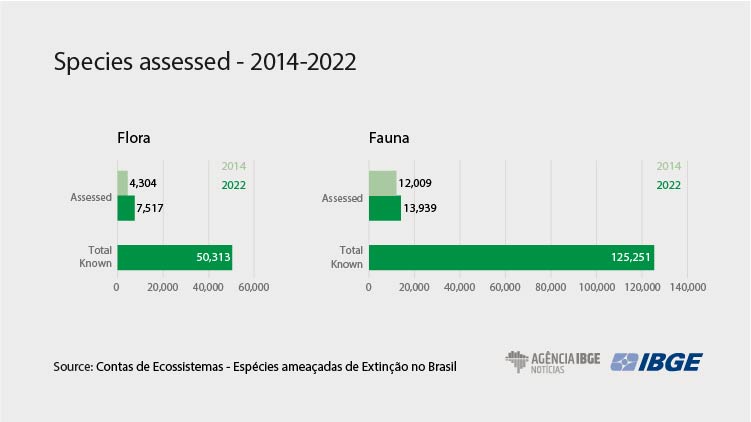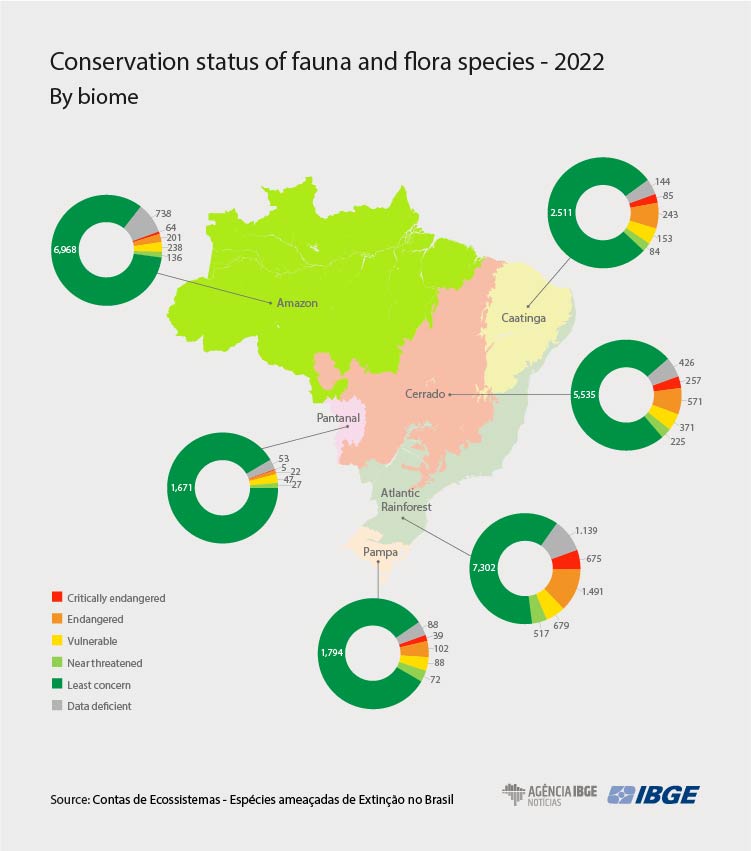Environmental-Economic Accounting
IBGE updates statistics on threatened species in Brazilian biomes
May 24, 2023 10h00 AM | Last Updated: May 25, 2023 06h29 PM
Highlights
- There are currently 50,313 species of plants and 125,251 species of animals known in Brazil;
- Within this universe, the number of assessed species increased between 2014 and 2022; in the case of flora, from 9% (4,304) to 15% (7,517) whereas fauna went from 10% (12,009) to 11% (13,939);
- The proportion of threatened species showed decreases both in flora (from 47.4% to 42.7%) and in fauna (from 9.8 to 9%) partially due to the increase in the number of species assessed up to 2022;
- Among the biomes, the Atlantic Rainforest kept the biggest number of species assesssed (11,811), most threatened species (2,845) and the biggest number of extinct species, which rose from 7 to 8, with the inclusion of the Campo Grande Treefrog (Boana cymbalum);
- The Cerrado (1,199) is number two in the ranking of threatened species, and the third one is the Caatinga (481):
- The Pantanal is still the biome with the smallest Absolute number of threatened species (74)
- This set of information comes from the survey “Ecosystem Accounts: threatened species in Brazil” of 2022. The first edition was released in 2020, with data of 2014.

The IBGE released today (24) the updated data on threatened species for year 2022. This set of information is part of the survey “Ecosystem accounts: threatened species in Btrazil”, released for the first time in 2020, with data of 2014. The revision is based on information in the new list of threatened species, released in December 2022 by the Ministry of Environment, in Ordinance GM/MMA no. 300. The lists are elaborated by Chico Mendes Institute for Biodiversity Conservation and (ICMBio) by the National Center for Flora Conservation of the Botanical Garden in Rio de Janeiro (CNCFlora/JBRJ).
From 2014 to 2022, the number of species assessed increased both in flora and fauna. There are currently 50,313 species of plants and 125,251 species of animals known in Brazil today. The quantity of species in flora went from 9% (4,304) to 15% (7,517) of the known species. In fauna, there was a smaller increase: from 10% (12,009) to 11% (13,939).

The species can be classified as “critically endangered”, “endangered” and “vulnerable”, according to methodological criteria established by the International Union for Conservation of Nature (IUCN), there were decreases in the proportion of both flora (from 47.4% to 42.7%) and fauna (from 9.8% para 9%), partially due to the number of species assessed in 2022.
The coordinator of the survey, Leonardo Bergamini, highlights that, although the proportion of the assessed species is small in relation to the total of species known, the constant efforts of the institutions involved have led to important advances in Brazilian biodiversity, which can guide protection policies that are adequate for the environment. “But there is still room for advance. As knowledge increases, it is not unusual that the sample include more non-threatened species than threatened ones, since there is a priority in the assessment of those with potentially more risk of extinction,” the researcher explains. “For that reason, we cannot guarantee the level of endangerment has decreased.”
Atlantic Rainforest remains as the biome with most threatened species
When considering threatened species from the perspective of Brazilian biomes, Bergamini explains that they all increased in absolute figures, except for the Pampa. According to the study, the Atlantic Rainforest, as well as in 2014, still has the biggest number of species assessed (from 9,042 in 2014 to 11,811 in 2022) and also keeps the biggest number of threatened species (from 2,016 to 2,845).

Along with it are other eight species of extinct native Brazilian fauna in different biomes: birds Eskimo curlew (Numenius borealis), cryptic treehunter (Cichlocolaptes mazarbarnetti), Alagoas Foliage-gleaner (Philydor novaesi), Pampas Meadowlark (Sturnella defilippii), Glaucous Macaw (Anodorhynchus glaucus), and Pernambuco Pygmy Owl (Glaucidium mooreorum); the amphibian Colored Leaf Frogs (Phrynomedusa fimbriata); the mammal Vespucci rodent (Noronhomys vespuccii), besides the bird Alagoas curassow (Pauxi mitu), an extinct species whose life depends on reproduction programs for animals in captivity.
The researcher also explains that the Atlantic Rainforest recorded significant drops in quantity of area of natural coverage throughout the centuries. “That was due to the bigger presence of anthropized environments, that is, those affected by been human action, due to the history of occupation and urbanization, from the shore inwards, in the formation of the Brazilian territory,” Mr. Bergamini says.
The change from 2014 to 2022 did not have an effect of the status of the Cerrado, which remained in second place in terms of number of threatened species in the two periods surveyed, with a change from 1,037 to 1,199. Then comes the Caatinga, with a change from 395 to 481. And the Amazon, with an increase from 311 in 2004 to 503 in 2022. The Coastal-Marine System also recorded an increase, from 166 to 170. The Pampa recorded a decrease from 234 to 229 species. The Pantanal, in spite of the increase by nine threatened species (from 65 to 74) remains as the biome with the lowest absolute figure, considering the total of species assessed.
“This figure found for Pantanal can also be related to the bigger preservation of ecosystems in this biome, as shown in our study about land use in this ecological approach, with an analysis elaborated between 2000 and 2020. That is the part of the territory with lowest losses in natural areas in the period,” he adds.
Assessment of species is most common in a terrestrial environment
Regarding the environment, most of the species assessed both for fauna and flora live in a terrestrial environment. There was an increase from 65% to 70%, between 2014 and 2022, evidencing the increase in knowledge and a focus in this type of ecosystem. Then come freshwater organisms, with a drop from 39% to 37%; and, finally, the marine environment (from 16% to 15%).
Regarding the combination of information about threatened species with that about the environment and biomes, the pattern of 2014 is also observed in 2022, and four combinations stand out with the biggest percentages, just ranked at different positions. The land flora of the Atlantic rainforest kept 43% of the threatened species in two periods, leading the biome-environment list of endangerment. The land fauna in the Coastal-Marine System accounted for 37% and went to the second position with 38% of the threatened species in 2022. It exchanged positions with the Cerrado land flora, which had 40% in 2014 and fell to 37% in 2022. Finally is the marine flora of the Atlantic Rainforest, which recorded an increase from 34% to 36% of the threatened species in the last eight years.“It is worth of mention that it is a relatively short period of time in the context of changes taken place in the country’s ecosystems,” Mr. Bergamini sums up.
The study Threatened Species is part of the IBGE’s Environmental Economic Accounting and represents one more step of the project for inclusion of other environmental indicators of the country in National Accounts.




















